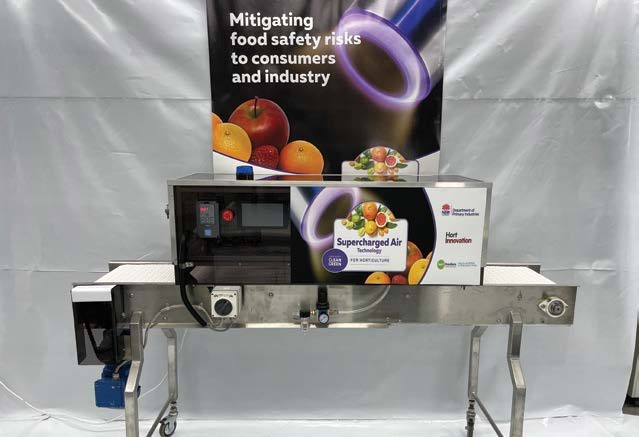Cold plasma
application in
horticulture:

towards a commercial reality
PLASMA-ACTIVATED water was demonstrated as a chemical-free treatment to achieve postharvest sanitisation.
The antimicrobial properties of cold plasma have gained significant attention.
BY DR SUKHVINDER PAL (SP) SINGH RESEARCH HORTICULTURALIST-FOOD SAFETY, NSW DEPARTMENT OF PRIMARY INDUSTRIES
In the last ten years, cold plasma has been under extensive research for its postharvest sanitisation application in horticultural products worldwide. It is now one step closer to offering horticultural growers a zero chemical residue option for food safety assurance and postharvest decay control.
Solid, liquid and gas are the commonly known states of matter, but plasma is regarded as the fourth state of matter. Plasma is generated by partially or completely ionising a gas under either low pressure or atmospheric pressure. Depending on the plasma generation methods, its temperature could range from near ambient to several hundred degrees Celsius. Plasma with near room temperature emission is known as cold plasma, non-thermal plasma, or supercharged air.
Though it is not as cold as the name suggests, cold plasma is much cooler compared to natural plasma, and reactive oxidising species present in the ionised air can kill or inactivate microbial pathogens.
The ability to generate non-thermal plasma at atmospheric pressure has expanded the horizon of its applications in thermosensitive products, including foods.
The physical and chemical characteristics of plasma have been widely exploited in various industry applications. However, the antimicrobial properties of cold plasma have recently gained significant attention and have led to the expansion of its applications in several industries, including food and medicine.
Testing the technology
The antimicrobial properties of plasma are of special interest to achieve postharvest sanitisation and decay control in highly perishable commodities.
The diversity of fresh produce morphology and physiology poses a challenge in developing a generic postharvest treatment that suits all products.
To combat this challenge, the NSW Department of Primary Industries and Hort Innovation have co-invested in developing, scaling-up and validating the cold plasma technology for postharvest sanitisation of horticultural products. In this project, the responses of various microbial pathogens to plasma were investigated and found to vary greatly with the pathogen type, produce-pathogen interactions and plasma treatment methodology. The project focused on exploring the potential of technology in killing foodborne bacterial pathogens such as Salmonella enterica, Listeria monocytogenes and E. coli. O157, which are commonly implicated in fresh produce-related outbreaks in Australia and globally. The cold plasma effects on the postharvest decay-causing moulds such as Botrytis cinerea, Penicillium italicum and P. digitatum were also investigated.
Promising trial results
Experimental results showed that the plasma killed or inactivated the target pathogens, depending on the exposure duration and the type of pathogen. Postharvest treatment protocols were optimised using lab cultures to achieve maximum killing or inactivation of target pathogens in the shortest possible time. The research was then extended to fresh produce inoculated with various pathogens and subjected to several plasma treatment regimes. Results showed that apples and citrus fruits were promising candidates for postharvest treatment with cold plasma.
Berries such as strawberries and blueberries, which currently do not have a postharvest washing step, also showed promising results to the cold plasma treatments. Some products, such as lettuce and spinach, showed limitations in their sanitisation with dry plasma treatment.
To extend the application of plasma to leafy vegetables, plasma was infused in the wash water, and the antimicrobial potential of plasma-activated water was demonstrated as a chemical-free treatment to achieve postharvest sanitisation.
Prototype development
To scale up and validate the cold plasma technology, prototype equipment was designed and tested to demonstrate its capability and potential for retrofitting in postharvest packing operations Comprehensive datasets were generated on the responses of various pathogens and effects on the sensory and nutritional quality of treated products.
The prototype is currently in a competitive commercialisation stage and is being demonstrated to industry stakeholders at major conferences, workshops, and events.
The development of this novel postharvest technology has provided the industry with an option of a rapid, chemical-free, non-thermal, environmentally friendly, and effective antimicrobial solution for food safety and decay control in horticultural products.
The prototype is currently in a competitive commercialisation stage.
Adopting this technology would lead to better food safety outcomes, mitigate postharvest losses, and reduce the reliance on some chemicals, resulting in improved environmental health and sustainability.
This technological intervention will enable the industry to maintain a competitive advantage by consistently supplying safe and healthy fresh produce to consumers in domestic and export markets.
Potential benefits of cold plasma treatment:
• Killing or inactivation of foodborne bacterial and viral pathogens
• Postharvest suppression of grey mould (e.g., Botrytis cinerea) on berries
• Extended shelf life.
MORE INFORMATION
See a video of the technology in action: vimeo.com/240577105
For further information, please contact Dr Sukhvinder Pal (SP) Singh on 0420 593 129 or sp.singh@dpi.nsw.gov.au
ACKNOWLEDGMENT
This project ‘Innovative cold plasma for horticultural industries’ was funded by the Hort Frontiers Health, Nutrition and Food Safety Fund, part of the Hort Frontiers strategic partnership initiative developed by Hort Innovation, with co-investment from the New South Wales Department of Primary Industries and contributions from the Australian Government.

► THE cold plasma prototype incorporates multiple treatment options and is fully automated, allowing safe application of the technology in packing operations.
